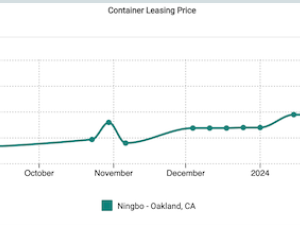Container shipping lines serving the Asia-US freight market have overhauled the way they calculate bunker fuel charges, to make the process more transparent and stabilize the cost impacts to customers.
Effective with their 2009-10 service contracts commencing May 1, 2009 or thereafter, member carriers in the Transpacific Stabilization Agreement (TSA) will begin the transition to a new bunker charge calculation formula developed by TSA as a group. The new formula, lines say, distinguishes between West Coast and East Coast sailings;'reduces volatility through quarterly adjustment; and addresses changes to vessel size, speed and fuel consumption in recent years.
'Vessel and operating characteristics have changed in the seven years since TSA last modified its bunker formula,' explained TSA chairman Ronald D. Widdows. 'In the current environment of price volatility, members saw an opportunity to improve the accuracy of their fuel cost calculations, while also accommodating shippers' calls for greater transparency in how the charge is developed.' TSA began working on the new formula in the late summer of 2008, as bunker fuel prices had hit a peak level of $767 per metric ton ' a 260% increase since the beginning of 2007. Prices have since fallen dramatically, but are expected to see continued volatility over time.
The simplified formula will be based on average weekly fuel prices published by independent tracking service Bunkerworld, for a smaller number of load ports ' Hong Kong and Los Angeles for a West Coast sailing; and Hong Kong and New York for an East Coast sailing. It assumes average vessel size, fuel consumption and steaming time for each routing, taking into account effective capacity for each type of vessel. TSA said the formula moderates volatility to customers in the charge itself, with a return to quarterly rather than monthly adjustment.
'TSA has taken a clear step forward with this new bunker formula,' Widdows said. 'It's simpler, more transparent, and more accurately captures fuel-related costs for local, intermodal and all-water East Coast service. It enables carriers to fully and fairly recover costs, and provides shippers with greater pricing predictability in planning their shipments.'
TSA will post the new formula shortly in the ancillary charges section of its website, HYPERLINK "http://www.tsacarriers.org" www.tsacarriers.org. The calculation page will track Bunkerworld average West Coast and East Coast weekly fuel prices over a 13-week period. It will provide a link to a fact sheet explaining the calculation formula in detail, with a table for easy translation of the 13-week average price into the upcoming quarterly bunker charge. And it will link to a page on the Bunkerworld web site confirming average weekly West Coast and East Coast prices, developed specially for TSA.
For an initial transition period through June 30, 2009, TSA will separately retain the weekly fuel price listings and calculation table for the existing formula on its web site, for the benefit of current 2008-09 service contracts.
TSA is a research and discussion forum of major container shipping lines serving the trade from Asia to ports and inland points in the US.
TSA members include:
| APL Ltd. | Hyundai Merchant Marine Co., Ltd. |
| China Shipping Container Lines | Kawasaki Kisen Kaisha, Ltd. (K Line) |
| CMA-CGM | Mediterranean Shipping Co. |
| COSCO Container Lines, Ltd. | Nippon Yusen Kaisha (N.Y.K. Line) |
| Evergreen Line | Orient Overseas Container Line, Inc. |
| Hanjin Shipping Co., Ltd. | Yangming Marine Transport Corp. |
| Hapag-Lloyd AG | Zim Integrated Shipping Services |





